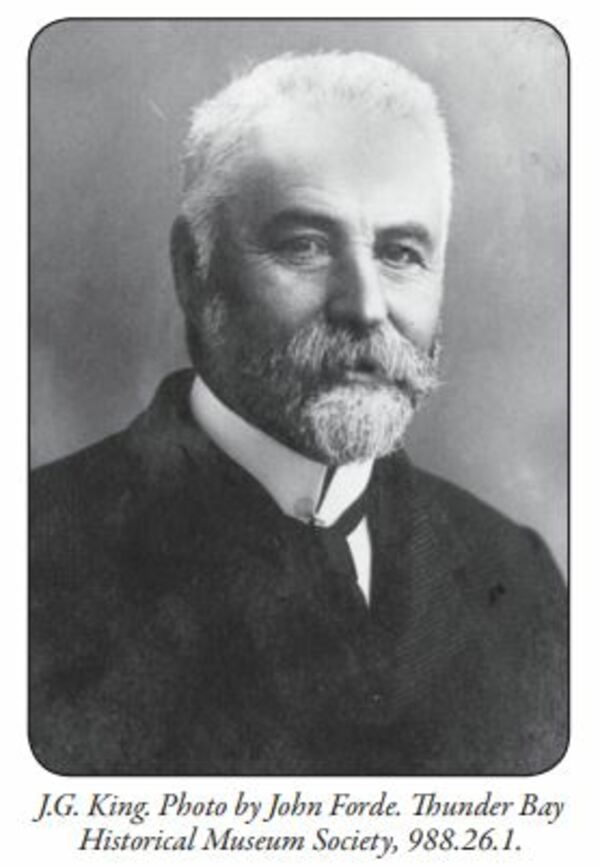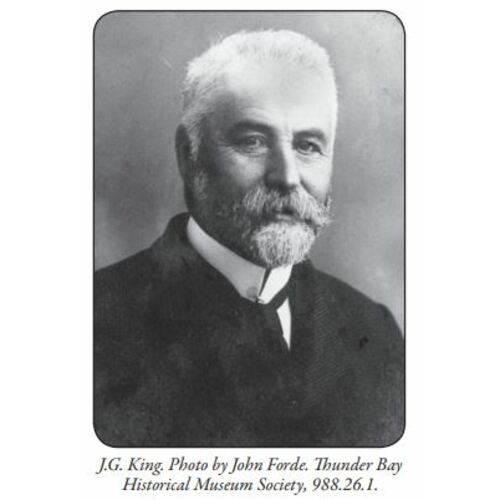
Source: Link
KING, JOSEPH GOODWIN, businessman and politician; b. 29 Feb. 1844 in Stowmarket, England, son of Benjamin Owen King and Emma Archer; m. 11 June 1871 Emma Julia Holdsworth in Port Hope, Ont., and they had five daughters; d. 30 June 1910 in Port Arthur (Thunder Bay), Ont.
The King family immigrated in the 1860s to the Lake Ontario counties of Northumberland and Durham. From about 1868 to 1877 Joseph operated King’s (Beamish) Flouring Mills at Port Hope. When this operation failed, he shifted to the grain-warehousing and elevator business, specializing in barley for export to the United States. In 1885 he claimed to have had 23 years’ experience in the grain trade.
Faced by declining markets and sharp competition from the Grand Trunk Railway elevator, King tried to stay competitive by improving the cleaning machinery at his 70,000-bushel elevator, but by the mid 1880s both he and Port Hope faced a bleak economic future. Looking west, he hoped in 1885 to obtain the newly created federal post of grain inspector at Port Arthur, where his brother, Richard Norman, managed the Ontario Bank, but the appointment went to Frank Egerton Gibbs (son of Thomas Nicholson Gibbs* of Oshawa). Efforts to associate himself with the Canadian Pacific Railway’s elevators also failed. Finally, John Mather of Ottawa hired him on 15 May 1888 as business manager of the Lake of the Woods Milling Company, at Keewatin, but by 1890, after a dispute with managing director Alexander Mitchell, he had returned to Port Hope as a grain buyer.
Despite these set-backs, events at the Lakehead soon drew King’s attention back to Port Arthur. William Cornelius Van Horne*, president of the CPR, was determined to dispose of its property there because of a vexatious tax dispute and to keep the company’s elevators out of the controversial business of mixing and scouring grain. King profited from the CPR’s pique by leasing on 19 Oct. 1891, for the purpose of cleaning grain, the 200,000-bushel wooden elevator it had built in 1883–84 to the design of Van Horne’s Milwaukee superintendent of elevators, James S. Harvey. He thus became the first private operator of a western terminal elevator. Undercapitalized, he entered into a five-year agreement in March 1892 with the town’s principal business family to form Marks, King and Company, two-thirds of the profits going to Thomas Marks* and his nephews. The business became so successful at salvaging damaged crops that King continued on his own in 1897. By then the wheat boom was well under way [see Joseph Harris*].
As proprietor of western Canada’s first hospital elevator, King pioneered the treatment of wet and smutty wheat. He constantly upgraded his cleaning and drying equipment, adapting the latest American machinery to Canadian conditions. In January 1903 the CPR contracted with Barnett and Record of Minneapolis to construct a nine-bin storage annex to the original elevator, the first instance of concrete bins in Canada (steel and tile had already been tried at the Lakehead). Though the wooden structure was demolished in May 1923, the concrete bins still stand.
As a town councillor at Port Hope (1880–86) and Port Arthur (1900–10), King was principally interested in public works, in particular urban beautification through parks and boulevards. He set a personal example by constructing King’s Gardens around his McVicar Creek property at Port Arthur. During terms as an electric-railway and electric-light commissioner, he aggressively pursued the development of electric power at Current River. King was a Conservative stalwart in Durham East; his confidence in the trade policies of Prime Minister Sir John A. Macdonald* wavered only when the export market for barley to the United States dropped. He ran twice for election to the Ontario legislature, losing to the formidable James Conmee* in the Algoma West by-election of 1895 and again in the general election in Port Arthur and Rainy River in 1902. A principled man, he earned the reputation of being “clean, fearless and honest.”
King’s career illustrates the rapid development of grain-handling technology in Canada. As an enterprising individual, he found opportunity in the developing west just as Ontario proponents of western expansion had hoped.
AO, F 256, 15 May 1888; RG 21, Port Hope, Ont., council minutes; RG 22, ser.398, J. G. King, 10 Aug. 1909. Canadian Pacific Arch. (Montreal), files 10622, 11039, 12371, 18205, 23904, 34216, 93928. Lakehead Univ. Library Arch. (Thunder Bay, Ont.), MG 5, no.51 (Flatt coll.), agreement of 16 March 1892. NA, Cartographic and Audio-visual Arch. Div., C-34685; MG 26, A: 17591–97; MG 28, III 20, Van Horne letter-books, 1: 778–79; 33: 236–39; 40: 751–52; Shaughnessy letter-books, vols.10, 26, 28–30, 43–45, 48, 50, 75–78, 98 (copies); RG 31, C1, 1871, 1881, 1891, Port Hope. Ogilvie Flour Mills Company Limited (Montreal), Lake of the Woods Milling Company Limited (mfm. at AO). St John’s Anglican Church (Port Hope), RBMB, 11 June 1871. Thunder Bay Hist. Museum Soc., photograph of J. G. King. Chronicle-Journal (Thunder Bay), 24 Feb. 1977. Daily Journal (Fort William [Thunder Bay]), 17 Jan. 1895. Daily News (Port Arthur [Thunder Bay]), 1 Aug. 1910. Daily Times-Journal (Fort William), 1 Aug. 1910. Morning Herald (Fort William), 1 Aug. 1910. News (Rat Portage [Kenora], Ont.), 29 March 1889. News-Chronicle (Port Arthur), 11 May 1923. Nor’West Farmer (Winnipeg), February 1892: 43–44; March 1892: 69; October 1894: 252–53. Port Hope Times, 26 Feb. 1891. Weekly Guide (Port Hope), April, 9 May, November, 26 Dec. 1884; 31 Dec. 1886; 7 Jan., 23 Sept. 1887; 19 April 1889; 6 March 1891. Weekly Herald and Algoma Miner (Port Arthur), 12 May, 2 June 1894. Weekly Sentinel (Port Arthur), 16 Nov. 1894; 17 Jan., 15 March 1895. “The Canadian Pacific grain elevator at Port Arthur, Ontario,” Engineering Record (New York), 49 (1903–4): 448–51. Canadian Patent Office Record (Montreal; Ottawa), 27 (1897), no.58070; 33 (1903), nos.80428, 80973, 81996. “Grain elevator maps of Thunder Bay,” intro. F. B. Scollie, Thunder Bay Hist. Museum Soc., Papers and Records, 6 (1978): 8–15. F. A. A. Talbot, “A wheat hospital,” Windsor Magazine (London, Eng.), 19 (1903–4): 729–34. Patricia Verwoort, “Lakehead terminal elevators: factors affecting survival,” Soc. for the Study of Architecture in Canada, Selected Papers (Ottawa), 5 (1982): 30–42.
Cite This Article
F. Brent Scollie, “KING, JOSEPH GOODWIN,” in Dictionary of Canadian Biography, vol. 13, University of Toronto/Université Laval, 2003–, accessed January 10, 2026, https://www.biographi.ca/en/bio/king_joseph_goodwin_13E.html.
The citation above shows the format for footnotes and endnotes according to the Chicago manual of style (16th edition). Information to be used in other citation formats:
| Permalink: | https://www.biographi.ca/en/bio/king_joseph_goodwin_13E.html |
| Author of Article: | F. Brent Scollie |
| Title of Article: | KING, JOSEPH GOODWIN |
| Publication Name: | Dictionary of Canadian Biography, vol. 13 |
| Publisher: | University of Toronto/Université Laval |
| Year of publication: | 1994 |
| Year of revision: | 1994 |
| Access Date: | January 10, 2026 |



